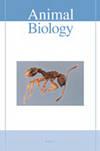Biology and integrative taxonomy of leaf folder, Helcystogramma hibisci (Stainton, 1859): a pest of musk mallow, Abelmoschus moschatus (L.) Medik.
IF 0.9
4区 生物学
Q2 ZOOLOGY
引用次数: 0
Abstract
Abstract The leaf folder, Helcystogramma hibisci (Stainton, 1859) (Lepidoptera: Gelechiidae) is an oligophagous pest of different malvaceous plants. In this study, attempts have been made to study the biology and taxonomy of the insect infesting musk mallow ( Abelmoschus moschatus ), an aromatic cum medicinal plant in India, following an integrative approach based on external morphology, internal genitalia structures, and molecular taxonomy. In the initial stage, the larva scrapes the tender surface of the leaves, and later, grown-up larvae web the leaves by folding them longitudinally. The entire inner content of the leaves is eaten by the larvae and ultimately the leaves get dry. The identity of the pest species is confirmed through dissecting of the male and female genitalia of the pest species and molecular confirmation (GenBank accession number ON545806). By studying the biology of the insect, the egg incubation period, larval period, and pupal period were determined to be 4.70 ± 0.64, 13.66 ± 0.86, and 6.46 ± 0.61 (male), and 7.60 ± 0.71 days (female), respectively. The average fecundity and adult longevity of males and females were 61.20 ± 11.68 eggs/female, 4.93 ± 1.38 days (male), and 8.06 ± 1.56 days (female), respectively. During their fourth instar, male larvae have dark-colored gonads that are easily visible on the dorsal integument of the abdominal segment distinguishing them from female larvae. Further confirmation of the identification was done by keeping the larvae in separate vials until emergence; larvae with this dark-colored character could be confirmed to be males, while other the larvae developed into female moths. The head capsule width of the larval instars was 0.26 ± 0.02, 0.47 ± 0.04, 0.66 ± 0.03, 0.83 ± 0.06, and 1.13 ± 0.14 mm, respectively. The information is useful for proper identification and management of this pest in such a valuable and popular plant as musk mallow in India. To our best knowledge, this is the first description of this pest species from the Indian region along with molecular confirmation.木槿Helcystogramma hibisci (stainon, 1859):麝香锦葵害虫Abelmoschus moschatus (L.)的生物学和综合分类Medik。
摘要:hibisci (Helcystogramma hibisci, stainon, 1859)(鳞翅目:姬蝇科)是一种寄生于多种恶性植物的寡食害虫。本文采用基于外部形态、内部生殖器结构和分子分类学的综合方法,对麝香锦葵(Abelmoschus moschatus)的生物学和分类进行了研究。在最初阶段,幼虫刮擦叶子的柔软表面,后来,成年幼虫通过纵向折叠叶子来编织叶子。整个叶子的内部物质被幼虫吃掉,最终叶子变干。通过解剖害虫物种的雌雄生殖器和分子确认来确认害虫物种的身份(GenBank登录号ON545806)。通过对其生物学特性的研究,确定其卵潜伏期为4.70±0.64 d,幼虫期为13.66±0.86 d,蛹期为6.46±0.61 d(雄),蛹期为7.60±0.71 d(雌)。雌、雄的平均产卵量和成虫寿命分别为61.20±11.68个/雌、4.93±1.38天(雄)和8.06±1.56天(雌)。在四龄期间,雄性幼虫有深色的性腺,很容易在腹部背被上看到,从而与雌性幼虫区分开来。通过将幼虫分装在不同的小瓶中直至羽化来进一步确认鉴定;具有这种深色特征的幼虫可以确定为雄蛾,而其他幼虫则发育为雌蛾。幼虫的头囊宽度分别为0.26±0.02、0.47±0.04、0.66±0.03、0.83±0.06和1.13±0.14 mm。这些信息有助于在印度麝香锦葵这样一种有价值和受欢迎的植物中正确识别和管理这种害虫。据我们所知,这是印度地区首次对这种害虫进行描述并进行分子鉴定。
本文章由计算机程序翻译,如有差异,请以英文原文为准。
求助全文
约1分钟内获得全文
求助全文
来源期刊

Animal Biology
生物-动物学
CiteScore
2.10
自引率
0.00%
发文量
34
审稿时长
3 months
期刊介绍:
Animal Biology publishes high quality papers and focuses on integration of the various disciplines within the broad field of zoology. These disciplines include behaviour, developmental biology, ecology, endocrinology, evolutionary biology, genomics, morphology, neurobiology, physiology, systematics and theoretical biology. Purely descriptive papers will not be considered for publication.
Animal Biology is the official journal of the Royal Dutch Zoological Society since its foundation in 1872. The journal was initially called Archives Néerlandaises de Zoologie, which was changed in 1952 to Netherlands Journal of Zoology, the current name was established in 2003.
 求助内容:
求助内容: 应助结果提醒方式:
应助结果提醒方式:


